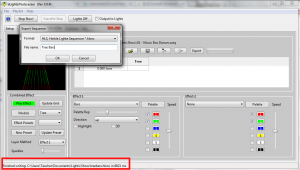Using Nutcracker with a PixelPlane: Difference between revisions
Jump to navigation
Jump to search
No edit summary |
No edit summary |
||
| Line 1: | Line 1: | ||
Outline for what to put here. Feel free to pitch in! | Outline for what to put here. Feel free to pitch in! | ||
Nutcracker: | |||
* | ====Introduction==== | ||
* | ---- | ||
Nutcracker is a pixel effect building system developed by [http://doityourselfchristmas.com/forums/member.php?10421-smeighan Sean Meighan]] which is cross-platform with a number of sequencers, including HLS. In February 2013, Nutcracker 3.0 was released, which moved from a web-based application to a software-based version in conjunction with [[xLights]]. The use of nutcracker is beyond the scope of this document, but you can read more at the following links: | |||
*[http://nutcracker123.com/nutcracker/releases/ Download Nutcracker, view tutorials, etc.]] | |||
*[[Nutcracker - RGB Sequence Builder|DIYC Wiki Documentation on Nutcracker]] | |||
*[http://doityourselfchristmas.com/forums/forumdisplay.php?102-Nutcracker DIYC Subforum on Nutcracker] | |||
====Nutcracker Setup for HLS==== | |||
---- | |||
[[File:HLS_Nutcracker_NutcrackerExport.png|thumb|Figure 6-28]] | |||
*When you configure Nutcracker, you should consider setting up the Pixel objects with the same configuration as your physical objects (ie, pixel count, strands, etc). HLS will utilize Nutcracker effects built for objects with different characteristics, but you will get more desired results from matching up configurations. | |||
*Nutcracker exports to hlsnc files. Basically, once you have created your effect, click Export in nutcracker, choose HLS, name your effect, and click OK. | |||
*'''Tip:''' Notice where Nutcracker is saving the export file by looking at the bottom of the window (see Figure X-X red highlight). | |||
**This folder is set by clicking ''File -> Select Show Folder'' in Nutcracker/xLights. | |||
<br clear=all> | |||
====Dropping a Nutcracker Effect Onto a PixelPlane==== | |||
---- | |||
====Using Start/Stop Markers for Adding Nutcracker Effects==== | |||
---- | |||
====Adjusting the Size of a Nutcracker Effect==== | |||
---- | |||
====Adjusting Speed of a Nutcracker Effect==== | |||
---- | |||
Revision as of 17:00, 7 March 2013
Outline for what to put here. Feel free to pitch in!
Introduction
Nutcracker is a pixel effect building system developed by Sean Meighan] which is cross-platform with a number of sequencers, including HLS. In February 2013, Nutcracker 3.0 was released, which moved from a web-based application to a software-based version in conjunction with xLights. The use of nutcracker is beyond the scope of this document, but you can read more at the following links:
- Download Nutcracker, view tutorials, etc.]
- DIYC Wiki Documentation on Nutcracker
- DIYC Subforum on Nutcracker
Nutcracker Setup for HLS

- When you configure Nutcracker, you should consider setting up the Pixel objects with the same configuration as your physical objects (ie, pixel count, strands, etc). HLS will utilize Nutcracker effects built for objects with different characteristics, but you will get more desired results from matching up configurations.
- Nutcracker exports to hlsnc files. Basically, once you have created your effect, click Export in nutcracker, choose HLS, name your effect, and click OK.
- Tip: Notice where Nutcracker is saving the export file by looking at the bottom of the window (see Figure X-X red highlight).
- This folder is set by clicking File -> Select Show Folder in Nutcracker/xLights.
Dropping a Nutcracker Effect Onto a PixelPlane
Using Start/Stop Markers for Adding Nutcracker Effects
Adjusting the Size of a Nutcracker Effect